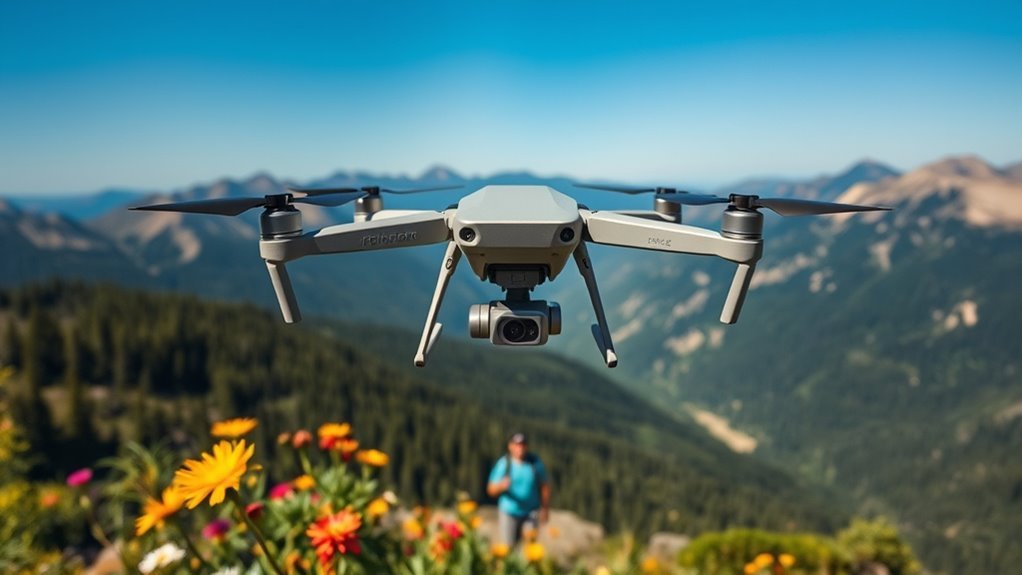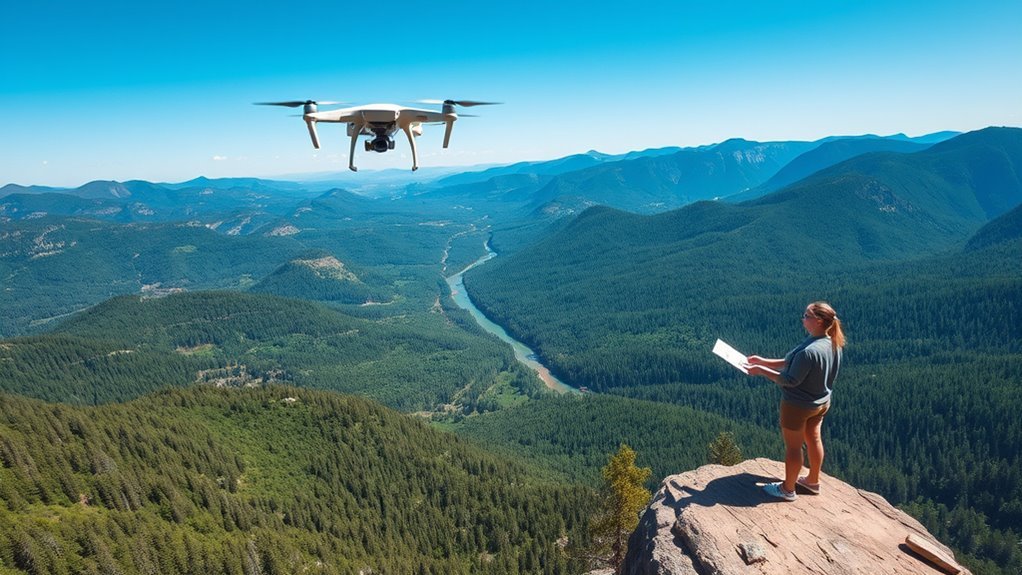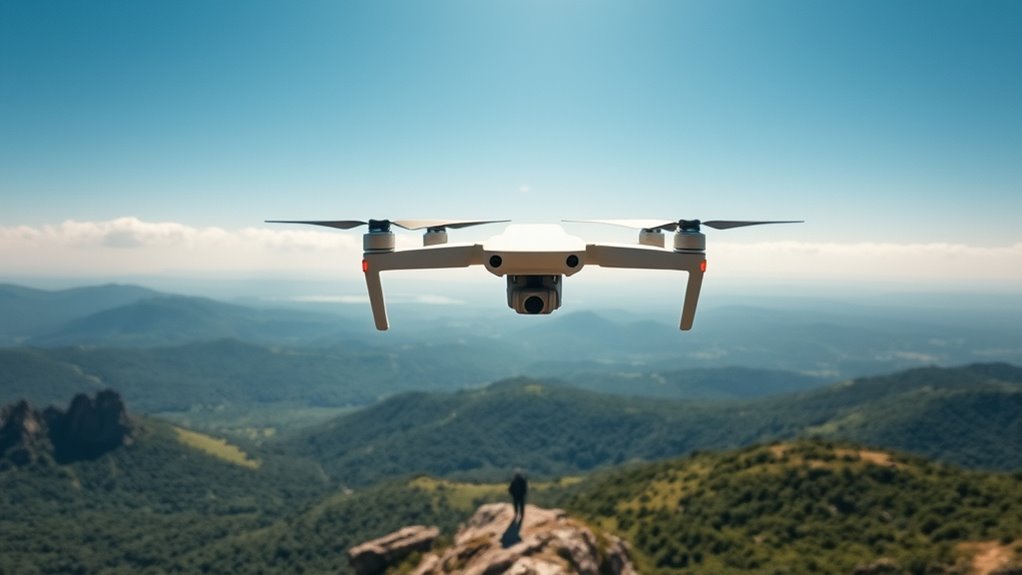If you want to fly drones in national parks, you must follow specific regulations that protect wildlife and the environment. First, check for permit requirements and apply in advance, as each park has its own rules. Always fly below 400 feet, keep your drone in sight, and avoid no-fly zones. Respect wildlife by maintaining a safe altitude and minimizing noise. By understanding these guidelines, you’ll guarantee a better experience—and there’s more to discover about responsible drone use.
Understanding the National Park Service Regulations

When you’re planning to fly a drone in a national park, it’s essential to understand the regulations set forth by the National Park Service (NPS). These rules are designed to protect both the stunning landscapes and the wildlife that inhabit these areas. While drone technology offers incredible opportunities for capturing breathtaking views, it can also disrupt the serenity and conservation efforts of national parks. You’ll need to familiarize yourself with specific restrictions, including designated no-fly zones and the necessity of obtaining permits in certain instances. By respecting these regulations, you’re not only ensuring a smoother flying experience but also contributing to national park conservation. Embrace the freedom of drone flying while being a responsible steward of these precious natural resources.
Federal Aviation Administration Guidelines

While understanding the National Park Service regulations is essential, it’s equally important to be aware of the Federal Aviation Administration (FAA) guidelines that govern drone operations across the United States. These rules guarantee drone technology is used safely and responsibly, prioritizing aviation safety for everyone.
Here’s a quick overview of key FAA guidelines:
| Guideline | Description |
|---|---|
| Registration | Must register drones over 0.55 lbs |
| Altitude Limit | Fly below 400 feet |
| No Fly Zones | Avoid areas like airports |
| Visual Line of Sight | Keep your drone within sight |
| Daylight Operations | Only fly during daylight hours |
Permits and Permissions Required

Understanding FAA guidelines is just part of the equation; if you’re planning to fly a drone in a national park, you’ll need to obtain the appropriate permits and permissions. The permit application process can vary by park, so it’s essential to check the specific requirements for your destination. Generally, you’ll submit your application to the park’s management well in advance of your intended flight. This guarantees you’re following their rules and helps maintain the park’s natural beauty and wildlife. Be prepared for a thorough review, as the permission process aims to balance recreational freedom with environmental protection. Remember, obtaining these permits not only keeps you compliant but also enhances your experience in the breathtaking landscapes of our national treasures.
Designated Flying Zones Within National Parks
Before you take to the skies with your drone, it’s essential to know that each national park has specific designated flying zones where drone use is permitted. These designated areas are vital for ensuring both your freedom to explore and the preservation of the park’s natural beauty. Be sure to check the park’s regulations beforehand, as flying restrictions can vary widely between locations. Some parks may only allow drone flights in certain sections or during specific times, so staying informed is key. Respecting these guidelines not only enhances your experience but also protects the environment and wildlife. Embrace the thrill of flying, but always keep those designated zones and restrictions in mind to enjoy your adventure responsibly.
Wildlife Protection and Safety Considerations
When flying drones in national parks, it’s essential to take into account wildlife protection and safety. Keeping a safe flight altitude not only helps you avoid disturbing animals but also guarantees a better experience for everyone. By following these guidelines, you can enjoy your drone adventure while respecting the natural habitat around you.
Wildlife Disturbance Prevention
While soaring through the skies with your drone can be exhilarating, it’s crucial to remember that many national parks are home to sensitive wildlife that can be easily disturbed. The drone impact on wildlife behavior can be significant, so here are some guidelines to keep in mind:
- Always maintain a safe distance from animals.
- Avoid flying near nesting sites or dens.
- Observe wildlife from afar; don’t approach them.
- Be mindful of your drone’s noise; it can scare animals.
- Respect park regulations regarding drone flights.
Flight Altitude Regulations
To guarantee both wildlife protection and your safety, it’s essential to adhere to flight altitude regulations while flying drones in national parks. Keeping your drone at safe altitudes not only guarantees drone safety but also minimizes disturbances to wildlife. Respecting these guidelines allows you to capture breathtaking views while protecting the natural beauty around you.
| Altitude Level | Impact on Wildlife |
|---|---|
| Below 200 ft | Minimal disturbance |
| 200-400 ft | Moderate stress for animals |
| Above 400 ft | High risk of disruption |
Best Practices for Responsible Drone Use
Although flying drones can enhance your experience in national parks, it’s crucial to follow best practices for responsible use. By adhering to drone etiquette, you’ll guarantee that everyone can enjoy the beauty of nature without disturbance. Here are some key points to keep in mind:
- Always keep your drone within sight.
- Respect wildlife by maintaining a safe distance.
- Avoid flying over crowds or near sensitive areas.
- Follow all park regulations and guidelines.
- Be mindful of noise levels to minimize disruption.
- Understanding local regulations is essential to ensure compliance and promote responsible flying.
Responsible flying not only protects the environment but also fosters a positive relationship between drone operators and nature enthusiasts. Your respect and consideration will contribute to maintaining the serenity of the parks for everyone.
Consequences of Violating Drone Regulations
If you violate drone regulations in national parks, you could face serious legal penalties, including hefty fines. Beyond the legal issues, your actions can also harm the environment, disrupting wildlife and damaging fragile ecosystems. Understanding these consequences is vital for anyone looking to enjoy the beauty of nature while flying their drone responsibly.
Legal Penalties Incurred
Violating drone regulations in national parks can lead to serious legal penalties that you might not expect. These legal repercussions can disrupt your freedom to fly and enjoy nature. Here’s what you could face:
- Fines: You might have to pay hefty fines that vary by violation.
- Drone confiscation: Your drone could be seized by park authorities.
- Criminal charges: In extreme cases, you could face criminal charges.
- Bans from parks: You may be prohibited from re-entering the park.
- Civil lawsuits: You could be liable for damages caused by your drone.
To fully enjoy your drone-flying experience, it’s essential to understand these potential penalties and fly responsibly within the law.
Environmental Impact Concerns
Flying drones in national parks isn’t just about enjoying the scenery; it also raises significant environmental concerns that can have lasting effects on wildlife and ecosystems. When you ignore regulations, you risk causing environmental degradation, which can harm delicate habitats. The noise and visual disturbances from drones can lead to ecosystem disruption, scaring away animals and disrupting their natural behaviors. Consider how your drone flights might interfere with nesting birds or migrating species. Each time you fly irresponsibly, you’re impacting not just the park’s beauty but its very fabric. By respecting the rules, you can enjoy the freedom of flying while ensuring these natural treasures remain intact for future generations. So, think twice before you take off!
Resources for Staying Updated on Drone Laws
While maneuvering through the ever-changing landscape of drone regulations, it’s essential to stay informed about the latest laws affecting national parks. Knowledge is power, and keeping up with drone law updates can help you fly responsibly and enjoy your freedom. Here are some key resources you should check regularly:
Staying informed about drone regulations is vital for responsible flying and enjoying your freedom in national parks.
- Federal Aviation Administration (FAA): The primary source for regulations that govern drone operations in U.S. airspace.
- National Park Service (NPS): Specific rules for each park.
- Drone User Forums: Engage with fellow drone enthusiasts.
- State and Local Regulatory Websites: Know the laws in your area.
- Social Media Groups: Follow updates and discussions on platforms like Facebook or Twitter. Staying aware of privacy regulations is crucial to ensure compliance while enjoying your drone flights.
Tips for Capturing Stunning Aerial Footage
Staying updated on drone laws not only keeps you compliant but also enhances your flying experience, especially when it comes to capturing stunning aerial footage. To make the most of your drone photography techniques, consider the golden hours—early mornings and late afternoons—when light is soft and shadows are long. Use aerial composition tips like the rule of thirds to create balanced and engaging images. Experiment with different angles and heights; a low-flying approach can reveal unique perspectives that elevate your shots. Don’t forget to keep an eye on your framing, ensuring the focal point stands out. Finally, be respectful of wildlife and park visitors, allowing nature to shine in your breathtaking captures. Happy flying!
Frequently Asked Questions
Can I Fly My Drone for Commercial Purposes in National Parks?
You can’t fly your drone commercially in national parks without special permits. Investigating drone regulations reveals strict rules designed to protect wildlife and visitors. So, if you’re dreaming of aerial footage, check those permits first!
Are There Age Restrictions for Flying Drones in National Parks?
There’re age limitations when flying drones in national parks. Generally, youth regulations require pilots to be at least 13 years old to operate drones, ensuring safety and responsibility while enjoying the freedom of aerial exploration.
What Should I Do if My Drone Crashes in a National Park?
If your drone crashes, don’t panic like a knight without armor. Focus on crash recovery first. Document the incident, then follow reporting procedures to notify park authorities. They’ll guide you through the next steps.
Can I Fly My Drone at Night in National Parks?
You can’t fly your drone at night in national parks due to night flying regulations. Plus, drone light restrictions limit visibility, making it unsafe. Always check local guidelines and prioritize safety for both yourself and wildlife.
Are Drones Allowed During Special Events in National Parks?
Drones aren’t always allowed during special events in national parks. You’ll need to check event regulations and obtain appropriate drone permits. Staying informed guarantees you enjoy your freedom while respecting park guidelines and other visitors.

